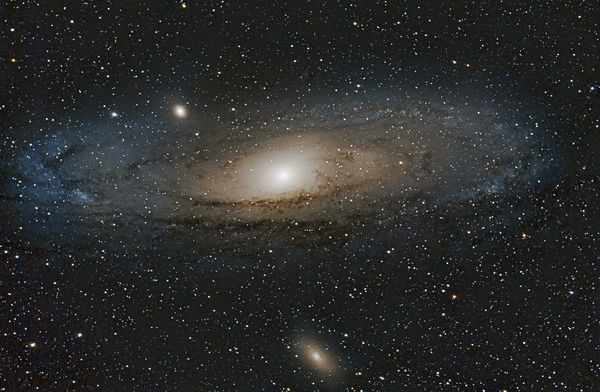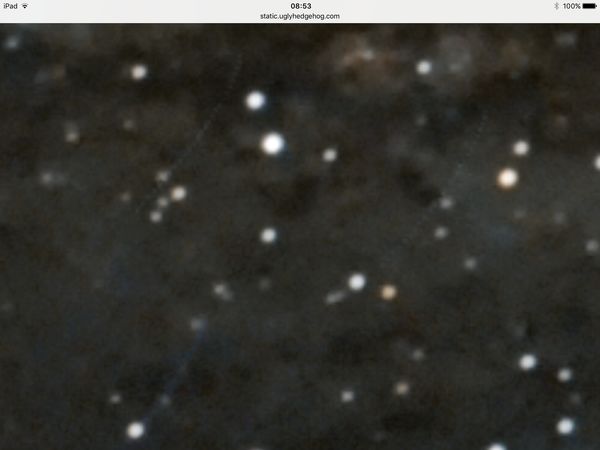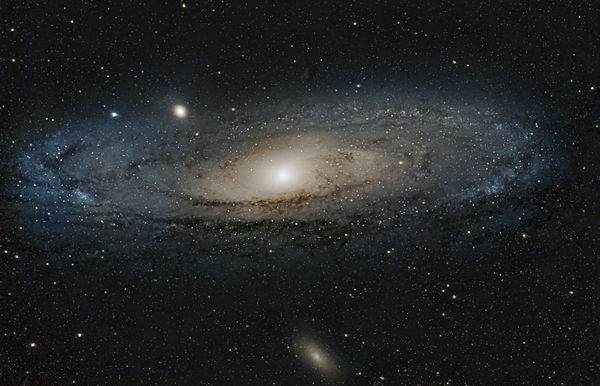M31 - Andromeda Galaxy
Jan 2, 2017 02:32:24 #
This is a stack of 75, 180 Second exposures with flats and bias. I gave up on the clouds going away, so I went ahead and processed what I had.
Jan 2, 2017 11:24:46 #
Europa wrote:
This is a stack of 75, 180 Second exposures with flats and bias. I gave up on the clouds going away, so I went ahead and processed what I had.
Really good. Did you do something to reduce the core? I normally find that the core is so bright compared the rest of the galaxy.
Jan 2, 2017 11:44:35 #
JimH123 wrote:
Really good. Did you do something to reduce the core? I normally find that the core is so bright compared the rest of the galaxy.
Thanks Jim, I was trying to keep the star color and keep them from getting too white and bloated. I think this helped keep the core down. I did take a bunch of 15 seconds, but never used them. I'll probably try this one again, as I didn't like how white the stars got.
What I did do for the core, was to take a less stretched layer and used a layer mask for the core.
Jan 2, 2017 11:58:20 #
i do have a question about dotted lines I always get, in the attached there are 3 dotted lines, I assume from not pixels??? Shouldn't these get removed with the bias?
I get them even when I use both darks and bias. Possibly they don't get removed because my guiding isn't good enough ( creating the dotted line) and not getting picked up as sensor noise?
I get them even when I use both darks and bias. Possibly they don't get removed because my guiding isn't good enough ( creating the dotted line) and not getting picked up as sensor noise?
Jan 2, 2017 13:23:58 #
I've seen those before in my own meager attempts. I think they are stacking artifacts.
I get around them by doing long exposure one shot color.
I get around them by doing long exposure one shot color.

Jan 2, 2017 13:36:05 #
SonnyE wrote:
I've seen those before in my own meager attempts. I think they are stacking artifacts.
I get around them by doing long exposure one shot color.
I get around them by doing long exposure one shot color.

Since they are so small I just use the healing brush in PS to get rid of them, must are all red, green or blue.
Jan 2, 2017 13:46:03 #
I don't see them in the main photograph. 
But I've witnessed them in a stack. That's why I thought they are dribbles from the stacking process.
(And they are symmetrical.) I'm not good enough to remove them.

But I've witnessed them in a stack. That's why I thought they are dribbles from the stacking process.
(And they are symmetrical.) I'm not good enough to remove them.
Jan 2, 2017 15:41:33 #
Europa wrote:
i do have a question about dotted lines I always get, in the attached there are 3 dotted lines, I assume from not pixels??? Shouldn't these get removed with the bias?
I get them even when I use both darks and bias. Possibly they don't get removed because my guiding isn't good enough ( creating the dotted line) and not getting picked up as sensor noise?
I get them even when I use both darks and bias. Possibly they don't get removed because my guiding isn't good enough ( creating the dotted line) and not getting picked up as sensor noise?
I see them, and they are all similarly curved the same way. What kind of mount were you using. And what focal length? Andromeda is quite large, and needs to be captured at low Power. Using an equatorial mount, I would not expect to see these unless polar alignment was way off. An ALT-AZ type mount could mean field rotation. I tend to think they are not stacking artifacts, but instead, they seem like hot pixels. I tried counting each dot, and I get 30 or so, but they are fuzzy enough that perhaps two dots are in each one? I was wondering if there was one dot for each image stacked? All 3 dotted lines seem to be the same size and same curvature. On any given single image, a stuck pixel is very sharp and defined. If you go back and closely look at just one, do you see a hot, stuck pixel that seems to be where the line is? And on another, does it show movement? If this is from field rotation, then possibly the fuzziness comes from the fact that it is so diluted down with the other images? What stacking SW did you use?
So thinking this through, a stuck pixel always is at the same spot on the sensor, no matter how many images you take. But if the scope is not exactly tracking properly, that stuck pixel will seem to move against the star background. The stacking process keys in on some stars it picks out, or in the case of Nebulosity, that you pick out. The stacking will lock the image so that it appears to not be moving, but that stuck pixel will now show it moving in relation to the now fixed image.
Jan 3, 2017 08:22:53 #
JimH123 wrote:
I see them, and they are all similarly curved the ... (show quote)
I'm using an EQ mount at 620mm. I stack in Nebulosity4. Also, these images came over a 3 night period. Ill have to go back to the individual images to see if I can detect the possible hot pixel from image to image.
So what you are saying, is because of the tracking, the "marching" hot pixel will not be detected by Nebulosity as a hot pixel, and the bias will not remove it?
Thanks.
Jan 3, 2017 08:37:38 #
Europa wrote:
I'm using an EQ mount at 620mm. I stack in Nebulosity4. Also, these images came over a 3 night period. Ill have to go back to the individual images to see if I can detect the possible hot pixel from image to image.
So what you are saying, is because of the tracking, the "marching" hot pixel will not be detected by Nebulosity as a hot pixel, and the bias will not remove it?
Thanks.
So what you are saying, is because of the tracking, the "marching" hot pixel will not be detected by Nebulosity as a hot pixel, and the bias will not remove it?
Thanks.
Yes, that sounds correct. And if you spot erase these pixels in the originals, then you won't see the dotted lines.
Jan 3, 2017 11:30:57 #
Europa wrote:
I'm using an EQ mount at 620mm. I stack in Nebulosity4. Also, these images came over a 3 night period. Ill have to go back to the individual images to see if I can detect the possible hot pixel from image to image.
So what you are saying, is because of the tracking, the "marching" hot pixel will not be detected by Nebulosity as a hot pixel, and the bias will not remove it?
Thanks.
So what you are saying, is because of the tracking, the "marching" hot pixel will not be detected by Nebulosity as a hot pixel, and the bias will not remove it?
Thanks.
Here's an idea. Try contacting Craig Stark, the creator of Nebulosity and describe your problem.
http://www.stark-labs.com/help/contact/contact.php
Jan 3, 2017 15:01:23 #
Artifact or not, that is a really nice stack.
You really have to dig to see the flaws.
Nicely done.
You really have to dig to see the flaws.
Nicely done.
Jan 3, 2017 16:33:58 #
Europa wrote:
i do have a question about dotted lines I always get, in the attached there are 3 dotted lines, I assume from not pixels??? Shouldn't these get removed with the bias?
I get them even when I use both darks and bias. Possibly they don't get removed because my guiding isn't good enough ( creating the dotted line) and not getting picked up as sensor noise?
I get them even when I use both darks and bias. Possibly they don't get removed because my guiding isn't good enough ( creating the dotted line) and not getting picked up as sensor noise?
I'm not too sure what you use for alignment/stacking. If you're using ImagesPlus, you can use the Min/Max Exclusion Combine to eliminate/reduce hot pixels. PixInsight also has similar parameters for stacking in its ImageIntegration. Since I never shoot/use bias, dark and flat subs I have to use pre/postprocessing software in this capacity; it (normally) works very well but I still haven't found a way to eliminate thick cloud
 .
.bwa
Jan 3, 2017 17:18:53 #
I've attempted to reduce the star brightness and bring in more color to the stars.
Jan 3, 2017 18:33:07 #
Europa wrote:
I've attempted to reduce the star brightness and bring in more color to the stars.
Certainly looking good on my cell phone!
If you want to reply, then register here. Registration is free and your account is created instantly, so you can post right away.





